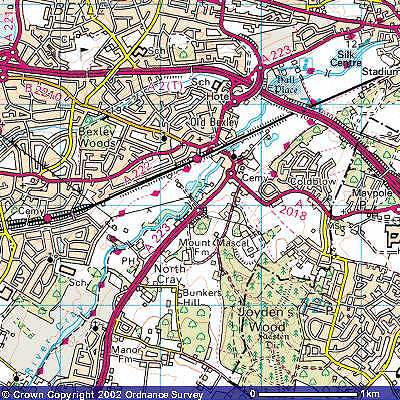|
Bexley
is at first sight a mass of 1930's housing on the fringe of S.E. London
(although expansion started with the arrival of the railway in 1866). A
quiet leafy suburb that looks to Kent as much as it looks to London.
Many
of the residents, however, work in the City or West End and commute in
to the centre each day.
The
old
village is still readily identifiable and contains a number of
interesting
buildings. John Thorpe's "High Street House" (1761) in the centre of the village, as is the Old Mill (1779, burnt down
1966,
rebuilt 1970), currently a rather mundane restaurant. The King's Head
dates
from the 16th century.
in the centre of the village, as is the Old Mill (1779, burnt down
1966,
rebuilt 1970), currently a rather mundane restaurant. The King's Head
dates
from the 16th century.
Attractive
St
Mary's church   is
at the south end of the village and dates from 1100. Styleman's
Almshouses is
at the south end of the village and dates from 1100. Styleman's
Almshouses  in
the centre of the village date from 1755. in
the centre of the village date from 1755.
Hall
Place   is
just to the east, along Borne Road, beyond the A2.(A more attractive
way
of reaching Hall Place from the village is along "The Cray River Way"
from
the south edge of the village and along the edge of Churchfield Wood
and
under the A2 where it crosses the railway). is
just to the east, along Borne Road, beyond the A2.(A more attractive
way
of reaching Hall Place from the village is along "The Cray River Way"
from
the south edge of the village and along the edge of Churchfield Wood
and
under the A2 where it crosses the railway).
Nearby
Footscray
Meadows   were created from the land of Foots Cray Place, which burned down in
1949.
Traces of the building can still be found at the northern fringe of the
meadows near the carpark off of Rectory Lane.
were created from the land of Foots Cray Place, which burned down in
1949.
Traces of the building can still be found at the northern fringe of the
meadows near the carpark off of Rectory Lane.
In
Rectory
Lane All Saints Church is at the western extremity of Footscray Meadows and can be the end of
a pleasant walk along the river Cray past the Five Arch Bridge
is at the western extremity of Footscray Meadows and can be the end of
a pleasant walk along the river Cray past the Five Arch Bridge  from
the village (Manor Way off of Hurst Road and past the cricket club then
past Upper College Farm and land now sadly used for landfill). from
the village (Manor Way off of Hurst Road and past the cricket club then
past Upper College Farm and land now sadly used for landfill).
A
little
to the NW of the village Bexley Park Wood   is
a fragment of ancient woodland surrounded by housing. is
a fragment of ancient woodland surrounded by housing.
At
the
south of the meadows on North Cray Road is Loring Hall (formerly
Wollett
Hall - 1760) which was the home of Lord Castlereagh (Irish and British
politician), a blue plaque commemorates his suicide there in 1822.
Stop
press!
"The
Red
House", William Morris's home in Bexleyheath has been purchased by
the National Trust and should be open to the public from the summer of
2003
Further
reading:-
Bexley Village
by
P.J Tester 
|
|














 The
red lozenges show the route of the Shuttle/Cray riverways. (Bexley
station
connects with London, Charing Cross and Dartford)
The
red lozenges show the route of the Shuttle/Cray riverways. (Bexley
station
connects with London, Charing Cross and Dartford)